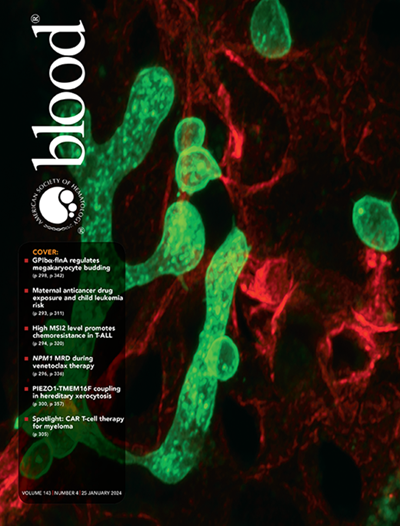Nuclear respiratory factor 1 promotes cell survival in multiple myeloma under proteasome inhibition therapy.
IF 23.1
1区 医学
Q1 HEMATOLOGY
引用次数: 0
Abstract
Multiple myeloma (MM) continues to be an incurable malignancy, even with recent therapeutic advancements. While epigenetic dysregulation at cis-regulatory elements is known to drive disease progression, the complete molecular mechanisms underlying these alterations are poorly understood. Using ATAC-seq analysis combined with computational footprinting of CD138+ cells from 55 MM patients, we depicted the dynamic changes in chromatin accessibility during disease progression and identified Nuclear Respiratory Factor 1 (NRF1) as a master regulator of vital MM survival pathways. We demonstrated that NRF1 maintains proteasome homeostasis by orchestrating the ubiquitination pathway, which is essential for MM cell survival. We discovered a novel enhancer element that physically interacts with the NRF1 promoter, sustaining its expression. Targeting this enhancer RNA reduced NRF1 levels and increased tumor cell sensitivity to bortezomib (BTZ), suggesting therapeutic potential. In xenograft models, we showed that antisense oligonucleotides (ASOs) targeting the NRF1 enhancer, either alone or combined with BTZ, significantly decreased tumor burden and improved survival. Our findings reveal a previously unknown NRF1-dependent mechanism regulating MM cell survival and present a promising therapeutic approach through manipulation of its regulatory network.核呼吸因子1在蛋白酶体抑制治疗下促进多发性骨髓瘤细胞存活。
多发性骨髓瘤(MM)仍然是一种无法治愈的恶性肿瘤,即使最近的治疗进展。虽然已知顺式调控元件的表观遗传失调可驱动疾病进展,但这些改变背后的完整分子机制尚不清楚。利用ATAC-seq分析结合来自55名MM患者的CD138+细胞的计算足迹,我们描述了疾病进展过程中染色质可及性的动态变化,并确定核呼吸因子1 (NRF1)是重要MM生存途径的主要调节因子。我们证明NRF1通过协调泛素化途径维持蛋白酶体稳态,这对MM细胞存活至关重要。我们发现了一种新的增强子元件,它与NRF1启动子物理相互作用,维持其表达。靶向这种增强子RNA降低了NRF1水平,增加了肿瘤细胞对硼替佐米(BTZ)的敏感性,提示治疗潜力。在异种移植模型中,我们发现靶向NRF1增强子的反义寡核苷酸(ASOs),无论是单独使用还是与BTZ联合使用,都能显著降低肿瘤负荷,提高生存率。我们的研究结果揭示了一种以前未知的依赖于nrf1的调节MM细胞存活的机制,并通过操纵其调节网络提出了一种有希望的治疗方法。
本文章由计算机程序翻译,如有差异,请以英文原文为准。
求助全文
约1分钟内获得全文
求助全文
来源期刊

Blood
医学-血液学
CiteScore
23.60
自引率
3.90%
发文量
955
审稿时长
1 months
期刊介绍:
Blood, the official journal of the American Society of Hematology, published online and in print, provides an international forum for the publication of original articles describing basic laboratory, translational, and clinical investigations in hematology. Primary research articles will be published under the following scientific categories: Clinical Trials and Observations; Gene Therapy; Hematopoiesis and Stem Cells; Immunobiology and Immunotherapy scope; Myeloid Neoplasia; Lymphoid Neoplasia; Phagocytes, Granulocytes and Myelopoiesis; Platelets and Thrombopoiesis; Red Cells, Iron and Erythropoiesis; Thrombosis and Hemostasis; Transfusion Medicine; Transplantation; and Vascular Biology. Papers can be listed under more than one category as appropriate.
 求助内容:
求助内容: 应助结果提醒方式:
应助结果提醒方式:


